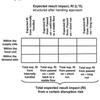 Recently I came across a report on Supply Chain Vulnerability published as early as 2002 by the Cranfield University School of Management on behalf of the Department for Transport, Local Government and the Regions, the Department of Trade and Industry and the Home Office. The key findings from this research report into supply chain vulnerabilities are quite interesting.
Recently I came across a report on Supply Chain Vulnerability published as early as 2002 by the Cranfield University School of Management on behalf of the Department for Transport, Local Government and the Regions, the Department of Trade and Industry and the Home Office. The key findings from this research report into supply chain vulnerabilities are quite interesting.
Key findings
Supply chain vulnerability is an important business issue.
Little research has been undertaken into supply chain vulnerabilities.
Awareness of the subject is poor.
There is a need for a methodology for managing supply chain vulnerability.
What else does the report say?
The report illustrates that modern supply chains are very complex, with many parallel physical and information flows occurring in order to ensure that products are delivered in the right quantities, to the right place in a cost effective manner. In fact, supply networks may be a more accurate term than supply chains. The shift towards leaner supply networks during recent years has resulted in these networks becoming more vulnerable.
In particular, there often tends to be very little inventory in the system to “buffer” any interruptions in supply and, therefore, any disruptions can have a rapid impact on the supply network.
These disruptions can arise from a number of sources, for example:
• natural disasters
• terrorist incidents
• industrial or direct action
• accidents
• operational difficulties
Owing to the close interrelationships between many supply networks, the impact of such disruptions can be far reaching and companies have been aware of the need for disaster recovery and emergency planning for some considerable time, particularly in areas such as information technology and production plants. The robustness of supply networks is thus recognised as being critical both for individual organisations and for the economy as a whole.
Whilst risk has always been present in the process of reconciling supply with demand, there are a number of factors which have emerged in the last decade or so which might be considered to have increased the level of risk. These include:
• A focus on efficiency rather than effectiveness
• The globalisation of supply chains
• Focussed factories and centralised distribution
• The trend to outsourcing
• Reduction of the supplier base
• Volatility of demand
• Lack of visibility and control procedures
Consequently, the diverse range of effects triggered by even a modest incident can fail to lead to underlying weaknesses being diagnosed if they are considered in isolation and not as part of the wider, overarching system. In effect, current understanding is underdeveloped and only capable of looking at pieces of the supply chain vulnerability jigsaw, without the ability to connect those pieces and see the wider picture. Business continuity and risk management, particularly with regard to information systems, appears to be fairly well understood and applied within individual organisations. The same is not true in terms of risk management in supply chains. Where awareness exists, a major impediment to the application of supply chain continuity management is the lack of an integrated programme of action or access to an appropriate ‘tool kit’.
Downloads
- cranfield.ac.uk: Supply Chain Risk Research











